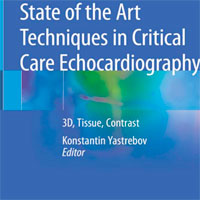Tag: ultrasound
POCUS in Cardiorespiratory Arrest
The POCUS-CA (Point-of-care ultrasound in cardiac arrest) is a diagnostic tool in the Intensive Care Unit and Emergency Department setting. The literature indicates that in the patient in a cardiorespiratory arrest it... read more
The Exciting Future of Our Physical Exam with POCUS
Point-of-care ultrasound (POCUS) is the natural progression of what Laennec started over 200 years ago, a tool he would undoubtedly add to his diagnostic repertoire were he able to, as he did with Auenbrugger’s percussion... read more
Point of Care Venous Doppler Ultrasound
Accurate assessment of the hemodynamic status is vital for appropriate management of patients with critical illness. As such, there has been a constant quest for reliable and non-invasive bedside tools to assess and monitor... read more
State of the Art Techniques in Critical Care Echocardiography
This book covers all aspects of modern techniques used in the rapidly developing field of adult critical care echocardiography, 3D transthoracic and transesophageal echocardiography, myocardial tissue velocity and deformation... read more

Prehospital FAST Reduces Admission Time and Treatment
The focused assessment with sonography in trauma (FAST) exam is an established trauma care diagnostic procedure. Ultrasound performed during prehospital care can improve early treatment and management of the patients. According... read more
Kidney Imaging with Point-of-Care Doppler Ultrasonography
We read with great interest the article by Caroli et al., in which they meticulously discuss the role of imaging in elucidating both structural and functional aspects of kidney disease. Herein, we would like to briefly comment... read more
Understanding Brain Injury in Pediatric ECMO
Brain injury is frequent in extracorporeal membrane oxygenation patients, although the majority of survivors have favorable neurocognitive outcomes. More research is needed in order to understand the etiology of such... read more
Diaphragm Ultrasonography in ICU: Why, How, and When To Use It?
An overview of the principles and current applications of diaphragm ultrasound and innovative ultrasound-based techniques. In the ICU, ultrasound is starting to be acknowledged as a useful tool for studying the diaphragm.... read more
Point of Care Ultrasound
Compact, hand-carried ultrasound devices are revolutionizing how healthcare providers practice medicine in nearly every specialty. The 2nd Edition of this award-winning text features all-new chapters, a greatly expanded... read more

POCUS Diagnosis of Medial Plantar Artery Pseudoaneurysm Secondary to Penetrating Injury
Pseudoaneurysms of the foot are rare and can occur from a range of etiologies, including laceration from a foreign body. The majority of reported cases have been diagnosed by computed tomography, magnetic resonance imaging,... read more
Point-of-Care Transcranial Doppler by Intensivists
In the unconscious patient, there is a diagnostic void between the neurologic physical exam, and more invasive, costly and potentially harmful investigations. Transcranial color-coded sonography and two-dimensional transcranial... read more
What is the Ideal Approach for Emergent Pericardiocentesis Using POCUS Guidance?
A total of 166 pericardial effusions were identified during the study period. The mean skin-to-pericardial fluid distance was 5.6 cm for the subxiphoid views, which was significantly greater than that for the parasternal... read more
Quantitative Characterization of LV Function During Pulseless Electrical Activity Using Echocardiography
Left ventricular function measured by LVFS is positively correlated with higher probability of rates of return of spontaneous circulation (ROSC) and may be associated with higher chances of survival in patients with PEA arrest. We... read more
The Predictive Role of Combined Cardiac and Lung Ultrasound in COVID-19
In hospitalized patients with coronavirus disease 2019, a very limited echocardiographic examination is sufficient for outcome prediction. The addition of echocardiography in patients with high-risk MEWS decreases the rate... read more
Percutaneous Ultrasound Guided Gastrostomy Tube Placement
Percutaneous ultrasound guided gastrostomy (PUG) is similar in terms of complications to percutaneous gastrostomy tube (PRG) placement and a safe method for gastrostomy tube placement in the critically ill with the added... read more
Ultrasound Grayscale Analysis in ARDS COVID-19
Recent evidence regarding the novel coronavirus disease 2019 (COVID19) is growing in describing the characteristics of this disease, with main focus on lung morphology. Few data are available regarding the peripheral and... read more
POCUS of the Heart and Lungs in Patients with Respiratory Failure
Point-of-care ultrasound (POCUS) is a focus oriented tool for differentiating among cardiopulmonary diseases. Its value in the hands of emergency physicians, with various ultrasound experience, remains uncertain. We tested... read more
Association of Low Baseline Diaphragm Muscle Mass With Prolonged Mechanical Ventilation and Mortality Among Critically Ill Adults
In this study, low baseline diaphragm muscle mass in critically ill patients was associated with prolonged mechanical ventilation, complications of acute respiratory failure, and an increased risk of death in the hospital. A... read more
Outcomes of Patients with COVID-19 and Relationship with Lung Ultrasound Signs
In patients with COVID-19 pneumonia, Lung Ultrasound Signs (LUS) signs, including the aeration score, were related to respiratory and systemic symptoms 1 month after ultrasound screening examination. In these patients, a... read more
Peripheral Arteriovenous Malformations: Classification and Endovascular Treatment
In this review we cover the classification and endovascular management of arteriovenous malformations (AVMs). We begin by viewing AVMs in relation to the broader class of congenital vascular malformations and subsequently... read more
Prehospital Management of Trauma Patients with Rib Fractures
Rib fractures are associated with a direct, blunt force trauma to the thorax. It is estimated that 10% of all patients who were admitted to the hospital after blunt chest trauma have at least one rib fracture. In the prehospital... read more
A novel, hands-free ultrasound patch for continuous monitoring of quantitative Doppler in the carotid artery
Quantitative Doppler ultrasound of the carotid artery has been proposed as an instantaneous surrogate for monitoring rapid changes in left ventricular output. Tracking immediate changes in the arterial Doppler spectrogram... read more









